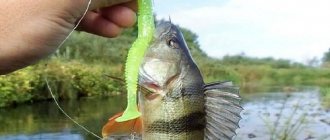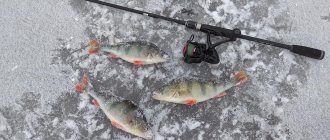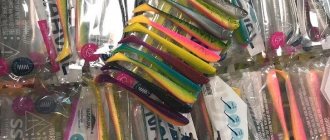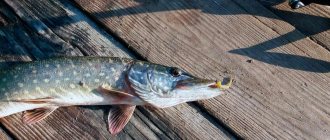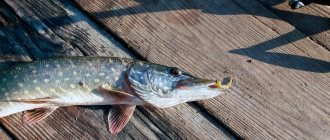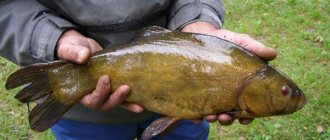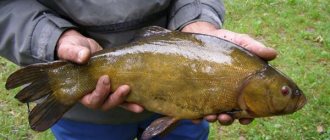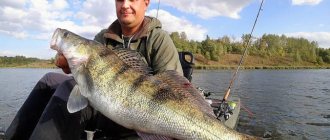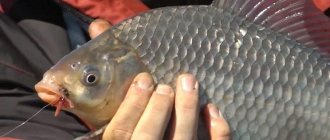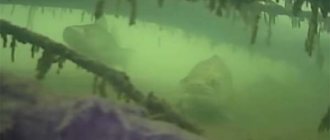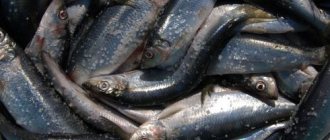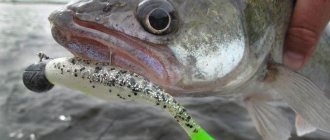Gear selection
Choosing jig tackle
There are serious requirements for jig tackle for catching pike perch. The kit includes the following components:
- spinning reel;
- network;
- leash;
- bait;
- jig rod.
The spinning reel in spinning gear must be balanced with the fishing rod. For a light jig, a reel numbered 2000 is used, for a heavy jig - numbered 3000, for ultralight - numbered 1000. The range of spinning reels is conventionally divided into three categories:
- budget (up to $50);
- mid-price range (from $50 to $150);
- expensive models (over $150).
Budget options are often of Asian origin. Such coils have some disadvantages, backlashes and gaps. And, nevertheless, they are suitable for beginner spinners.
Reels in the mid-price range are of higher quality. The use of lightweight materials, smooth running and high power allow the vast majority of jigging enthusiasts to use these reels.
The rod is selected from the fishing location:
- From the shore, it is better to choose a longer rod 3.2-3.8 m
- From a boat, a shorter one of 2.1-2.7 m is suitable
It is desirable that the rod be quite rigid, namely, that the tip of the rod be rigid. When hooking, it is important to hook the thick skin of the pike perch, but due to the soft tip this is problematic.
The reel is inertialess or multiplier. The inertia-free system is widespread among fishermen, is easy to use and has all the necessary functions (one of the most important is the friction clutch). The rear clutch of the reel is less sensitive than the front one, take this into account when purchasing a reel, although a reel with a rear clutch can also be well adjusted.
The fishing line is a braided cord, there can be no other options. Braid, unlike monofilament and other types of fishing line, does not stretch when tensioned, and this is very important when getting bites at a distance far from the angler, and even at great depths.
The diameter of the fishing line is selected depending on its breaking load (different manufacturers have different strength indicators of the fishing line). When catching small pike perch, up to two kilograms of braid with a diameter of 0.12 is quite enough.
Despite its simplicity, the choice of gear for jig fishing must be approached responsibly and scrupulously. The fishing result depends on how correctly they are selected and balanced.
Good, harmonious gear will allow you to feel all the bites, qualitatively “feel” the bottom topography, hook and bring out large pike perch, and will not lead to fatigue during the day of fishing. An unbalanced set, on the contrary, “eats” sensitivity and causes discomfort when fishing.
Spinning
Spinning tackle for pike perch fishing consists of the following main elements:
- spinning rod;
- spinning reel;
- main line;
- bait.
Rod selection
Spinning fishing is characterized by the fact that you need to constantly cast. To prevent fishing from turning into a tedious activity that takes a lot of strength and energy, you should choose the right fishing rod. It should be light and comfortable.
The length of the rod is selected within 2.4-3 meters. The further you plan to cast the bait, the longer the rod should be. In addition, the presence of various types of vegetation on the shore of the reservoir suggests the use of forms no more than 2.4 m long. If you plan to fish from a boat, then a spinning rod 1.8 meters long is sufficient.
You can use live bait when fishing for pike perch on any gear, for example:
- float rod;
- bottom tackle;
- on mugs.
Advantages of braid for spinning rods. Which is better
Over the past ten years, braided lines have almost completely replaced the previously common monofilament lines from the spinning industry. This is not surprising in the development of spinning, since braid brought additional opportunities to this method of fishing, allowing fishermen to more effectively catch predatory fish using new baits and methods.
Modern multi-filament cord has the following advantages:
- Almost complete absence of stretchability, which greatly increases the sensitivity of the gear.
- High strength compared to monofilament line of the same diameter.
- Increased abrasion and wear resistance.
- Better flight.
- High reliability overall.
And here's what you need to know: Selecting and winding the cord for the feeder
Thanks to cords, such fishing methods as jig, twitching, jerking and others, where the inextensibility of the line plays an important role, have received tremendous development. Braid made it possible to fish more effectively with silicone and bulky plastic baits.
It was also useful in ultralight, especially in microjig, where without sensitive non-stretchable braid it is almost impossible to carry out the correct wiring and notice the fish biting.
Jigs and heads for pike perch
The most popular jig head shape is the ball. Such sinkers are very versatile; ball jig heads can be used for fishing in any conditions and at any depth. Also in your arsenal is worth having fish-head type jig heads, which are characterized by better aerodynamics and less snagging, and therefore are well suited for fishing on rocky bottoms and in strong places.
Sinker weight
Selecting the correct weight of the load is a key point in catching pike perch with a jig. The specific weight of the jig head depends on the depth at the fishing site, the strength of the current, the activity of the fish and the size of the baits used. In most fishing situations, it is necessary to select such a weight so that the time the bait falls to the bottom during a stepped retrieve is 2-4 seconds.
When fishing for pike perch on large lakes and reservoirs, the following weights are required:
- at depths up to 2 m - 4-8 g;
- 2-4 m - 6-12 g;
- from 4 to 6 m - 10-14 g;
- 6-10 m - 14-20 g;
- at a depth of more than 10 m - 18-30 g.
In currents, accordingly, it is necessary to use heavier weights (the stronger the current, the greater the mass of the load should be).
Rig with eared sinker
In addition to jig heads, rigs with a double or offset hook connected through two winding rings with an eared weight are used in pike perch fishing. Such a hinged connection of the hook with the sinker allows for greater freedom of the bait and, accordingly, a more lively game, and the use of offset hooks or
Jig baits for catching pike perch
A standard bait for catching pike perch is narrow, with a purlin shape and a length of 7 cm. Today's market presents a wide range of silicone baits of different shapes, sizes and colors.
Promising colors when hunting fanged: orange, light green, “machine oil”, options with sparkles.
Today, silicone baits have added another positive characteristic - the presence of an attractant. Silicone baits, rich in odor, have an advantage over conventional jig baits. Popular brands of edible silicone: Fanatik, LuckyJohn, Keitech.
Important: When catching pike perch with a spinning jig, you should never discount the good old foam fish. When fishing for demolition, a “foam rubber” can work wonders in pike perch fishing.
There are two ways to equip a silicone or foam fish with a weight and a hook. And in the case of pike perch, both of these methods are appropriate:
- jig head with a soldered hook (fixed installation);
- “Cheburashka” weight and offset hook (hinge mounting).
Jig baits for pike perch
For targeted catching of fanged fish, choose silicone baits with a long body.
Often, when catching pike perch, soft silicone baits of two main types are used. These are vibrotails and twisters. As for the vibrotail, its appearance imitates a small fish. Its main working part is a tail with a small snout. The tail plays from side to side, which attracts pike perch.
Twister is rather intended as an imitation of a worm. Its tail can proportionally reach a length greater than half the total length of the bait. While performing the retrieve, the tail curls beautifully in the water, thereby provoking the pike perch to make a lightning-fast attack. The disadvantage of the twister is that often the predator tears off the tails and the bait becomes unsuitable for fishing. To be fair, I will say that the vibrotail is also not without this drawback.
In addition to the most common silicone baits, you can also find other baits on sale. Imitations of crayfish, octopuses, bucktails and imitations of various insects. Due to their unusual appearance, they are used less often in fishing than traditional vibrotails and twisters.
Separately, there are baits made of edible rubber. These can be silicone baits of any type. The main feature is not the shape, but the material from which they are made. The fact is that edible silicone baits contain a special attractant that reminds a predator of the smell of a live fish or crustacean. It is believed that the edible fish works more effectively in cold water and is indispensable for spring and autumn pike perch fishing.
Recommended reading: Red sea bass
On a note! Pike perch attack bait made from edible rubber much more readily than bait made from simple silicone. In addition, after taking a bite, the fanged robber is in no hurry to spit out such bait from his mouth. This gives the spinner the opportunity to hook at the appropriate time.
How many threads should there be in the cord?
1. Where fishing will most often occur; 2. What kind of fish would you like to see in your catch? 3. What baits will we use;4. What are the characteristics of the spinning rod and reel?
Now in more detail point by point.
https://www.sibrybalka.ru/snas/o_pletenyh_leskah/ - a detailed and interesting article about braided cord and its correct selection.
Each braid manufacturer has its own technologies that make it possible to obtain a product with the required parameters. Today there are only a few manufacturers of raw materials for the further production of braiding. All fishing concerns purchase there, and then at their facilities they produce braided fishing lines, which go on sale.
An important indicator of the quality of a braid is the way the fibers are woven. Famous manufacturers use technologies in which the fibers are woven tightly, forming an almost perfectly round cross-section. Such braided fishing lines have the following output indicators:
- Highest strength with the smallest possible diameter.
- No stretchability.
- Durability, since dirt and suspended matter in the water practically do not get between the fibers of the cord.
- Wear resistance, braids do not become shaggy after several fishing trips, they are best used in difficult conditions.
Inexpensive cords do not have such a dense weave, and some manufacturers simply place the fibers side by side without intertwining them. Such multi-filament threads have an uneven diameter along the entire length, are often flattened, have a small margin of strength and quickly become unusable. Therefore, it is obvious which braid is better for spinning and what to look for when choosing it.
You can name several models of braided cords that have proven themselves in jig fishing. Braided lines can be 4 or 8 strands, but 4 strands are enough for jigging.
And here's what you need to know: How to cook peas for fishing Bait for bream ide steamed peas Fishing for peas
In addition, 4-core braided lines are thinner, which is a plus if you fish with microjigs. But for classic jig fishing with baits over 5 grams, 8-core braided lines will work well in terms of flight range and sensitivity.
When choosing a cord, the number of veins will also be influenced by the fishing method. If fishing is done with a vertical jig, then 8-strand braid can be used.
When casting from the shoreline, part of the braid will fail after several fishing trips. Although the abrasive properties of the cords are high, they still rub against stones; in this case, it is not advisable to use 8-core braided cords; they are quite expensive.
For which gear which is preferable?
Today's angler can catch pike using the following gear:
- summer and winter spinning;
- mugs;
- summer and winter vents;
- live bait float rod.
Spinning is the most modern equipment that can be used for pike fishing. The variety of spinning fishing methods is quite large. And each of them has its own specific selection of components.
Tips for a fisherman: How to put girders on pike in winter - Let's take it step by step
Twitching, jigging and trolling are spinning fishing methods that require great sensitivity and reliability of equipment. Therefore, if fishing is done using these methods, then braided fishing will be optimal in this case.
The use of spinners, both rotating and oscillating, requires the use of monofilament fishing line. It is less noticeable and does not alarm pike so much in the upper layers of the reservoir. Fishing with a rig with a dead fish is more effective when using a fishing line, since a springy fishing line makes casting the bait softer, which injures the bait less and is enough for a greater number of casts.
Ultralight spinning fishing requires minimal windage and invisibility of equipment in the water. Therefore, in this case, monofilament line or fluorocarbon are suitable.
Given the high abrasion resistance of fluorocarbon, it can be used as a leader when fishing for small grass pike. When fishing for larger pike, a steel leader is a must, because monofilament line, braided line, and fluorocarbon will be easily rubbed by pike teeth.
Winter lure requires the use of delicate and inconspicuous fishing lines. This is due to the winter passivity and caution of fish in winter. Typically, ice fishing line is more resistant to cold water and is labeled "ICE".
Catching pike with mugs can be accompanied by very high cutting pressure on the hand. Therefore, a thick nylon cord is used as a base, to which a monofilament leader is attached, after which a steel leash is attached.
For summer and winter girders, it is advisable to use fishing line. In winter, the temperature does not allow the use of wicker. A frozen braid will have a damaged weave, and it can very quickly become unusable. And in summer, fishing line has superiority over braided line because it is less noticeable. For the zherlitsa, this question is very relevant, because this is a passive method of fishing and the striped predator can easily examine the bait and all the equipment.
A live bait float rod requires soft casting of live bait, delicacy and inconspicuousness of the equipment, so in this case a monofilament fishing line would be preferable.
The places where you can catch pike are quite varied. But I will try to focus on places for beginners, places that do not require special gear and bait.
It is quite difficult to master a new type of fishing and/or a new type of fish.
And lately on fishing forums I often see messages: “I want to catch pike, I have a spinning rod, baits, I’ve been rinsing them in the water for a long time - but there’s nothing” - but the “seasoned” ones don’t rent out places - but everyone has been in this situation, That's how I started!
Next, I will try to describe my experience in mastering catching this wonderful fish with a spinning rod. Let me make a reservation right away that in this article I am not talking about fishing with jerkbaits, and my advice will be primarily aimed at ensuring that you catch the first pike, start fishing for pike, and do not give up the spinning rod after many unsuccessful attempts. Most likely it will be a small pike up to a kilogram, but once upon a time it was the 300 gram cord that brought me a lot of joy and opened up a new, currently favorite type of fishing for me and my comrades.
For successful fishing you need to know: 1. when, 2. where, 3. what bait to use 4. what (spinning rod, line, reel)
When to catch pike.
Spring: for me, spring pike fishing begins in the second half of April, with the appearance of the first yellow dandelion flowers, lasts a couple of weeks, often coincides with a period of high activity and breeding of vipers. The peak activity of pike, when it simply “jumps out of the water”, is several days. A popular sign of spring activity of pikes is the blooming of birch catkins - but nothing worked out for me with this sign :).
In summer, pike activity is much lower, however, if you manage to find an overgrown reservoir with clean, spring water, then you can get a lot of pleasure from fishing with poppers, spinnerbaits, and bassbaits throughout the hot period.
Where to catch pike.
The places where you can catch pike are quite varied. But I will try to focus on places for beginners, places that do not require special gear and bait.
Spring - go to the canals connecting to the Don, you can read more in the article “Catching pike on a canal with a spinning rod in spring”
Summer - overgrown reservoirs with clean, spring water.
Autumn. The most interesting are small rivers with a calm flow, shallow depth, and an abundance of small fish, coastal vegetation and algae. A photo of a typical “initial” pike river on a typical autumn pike day is shown below.
Fishing takes place in the coastal zone, at a depth of 0.5 to 1-1.5 m. The most interesting zone here is the border between clear water and duckweed washed ashore. As a rule, the pike is located directly below it. Border of clean water and algae. Areas along the walls of the reeds, provided that the depth is at least half a meter starting almost immediately from the reeds.
When fishing, pay attention to underwater valisneria bushes, especially those located in an area with a bottom sloping towards the riverbed. Placing the bait near them, between them, or, if the depth allows, directly above them often produces results.
Sometimes the smallest pike stands right in the reeds in “bays” 10x10 cm and up to 10 cm deep, it is usually visible, and attacks with a very accurate hit under the nose.
To begin with, I can recommend the Aksai River in the area of the villages of Bolshoi Log, Pchelovodny, Aleksandrovka.
The second autumn option is the channels between the islands and the shore on the Don River, especially their coastal zone on the side of the island, the depth in this zone is approximately 0.5-2 meters, with a gradual increase towards the channel. For example, the shores of Green Island.
If you decide to go to the Don, be prepared for the fact that you can walk more than one kilometer before you find a pike. And, unless you know the area exactly and have a lead, Don is not the best place to start.
A characteristic feature of a pike place can be fishermen with spinning rods, with a “dead fish” attached to them, small fish on the shore - they usually fish with fishing rods with large floats and have a container for fry nearby, small fish on the water - fishermen on rubber boats freely drifting along pond with small fishing rods. In a place where small fish are found on boats, as a rule, jig fishing will bring success.
Lures
Pike baits are extremely varied. Spoons, rotating and oscillating, wobblers, poppers, jig baits (silicone), jerk. Most of them require certain qualities from the spinning rod and reel.
To start catching pike, I consider it optimal to use spinners - they are quite versatile, do not require special properties from a spinning rod, line and reel, are inexpensive, and do not require special skills for fishing. In second place I would put oscillating spoons, silicone.
Tips for a fisherman: How to choose a spinning rod for pike fishing - Tips for a beginner
A backup option is vibrators and silicone.
Oscillating spoons 4-7 cm long, because... I describe fishing at shallow depths, then I advise you to take light ones, weighing up to 10 - 15 grams. I prefer daiwa crusader 7 g, or cuusamo professor non-snagging, or rapala minnow spoon 5-7 cm. If you need to fish a deeper area, you should pay attention to spoons from Abu Garcia (I love this company) - Atom, flamingo, pike, interesting The Pike spinner (pike) does not go deep when cast evenly, it catches pike from 0.5 kg, flamingos are not produced now, but the spinner is magnificent.
Typical summer baits are a bassbait (at the top of the photo), a spinnerbait - they can be carried out evenly, the bassbait should go along the surface, creating splashes, but you can also lead it in the water column, the spinnerbait is more often carried out in the water column. Read more about the use of bassbaits, spinnerbaits and poppers in the article about summer pike fishing.
A special selection of lures for pike fishing are jerky lures that specialize specifically in pike fishing. Read about jerk fishing as a special type of pike hunting in this article.
Spinning rods.
Coil.
You shouldn’t chase too much for the number of bearings; 2-3 are enough to start with. An endless screw is needed primarily for jerk fishing with wobblers; such a reel should be purchased in the process of mastering wobbler fishing and when specializing specifically in wobblers. For jigs and spinners, you don't need an endless spinner.
If we talk about better quality infinity reels, then, in addition to the well-known and well-known Shimano and Daiwa, I advise you to pay attention to the SPRO BlueArc and blakc arc reels
I would recommend PowerPro 0.15. Universal, inexpensive. The length is at least 150 yards, 90 yards in the process of drops will quickly end.
It is possible to use low-stretch monofilament 0.22-0.25, I prefer Suffix; I would prefer braided line to more expensive Shimano monofilaments.
For spinners and jigs, any normal quality leash is suitable, with the exception of fishing with a twister without a load and a Carolina rig - here you need a lighter leash about 10 cm long. Personally, I prefer carabiners and leashes with a breaking load of at least 20 kg, because in fact, they often break much earlier.
Searching the area.
Wiring a twister on an offset machine is similar to wiring an oscillating spoon, except that it is done superficially and you should not try to lower it to the bottom.
The concepts of reeling slowly and quickly are quite relative - but if you catch a pike, remember the rate of rotation of the reel - try to continue to use it, perhaps here and now the pike needs exactly this rate.
Wiring during summer fishing with bassbaits and spinnerbaits consists of guiding them evenly on one side along the border with vegetation, through it, on the other hand, when the depth at the fishing spot is 1-1.5 meters and there is a continuous carpet of algae on the bottom from the space of free water above them, 30-50 cm, you need to place the bait just above the algae, the pike attacks the bait rising from below. However, more details about summer pike fishing, including with poppers, will be written in the corresponding article.
So the season and place are determined, there is gear and bait, what else? You also need comfort and convenience.
Be sure to take a clamp or pliers with you - pulling the hook out of the pike's mouth is not always safe for your fingers.
It is worth considering purchasing wading boots; they will help keep your feet dry, your shoes clean, and allow you to go into the water and cast reeds or seaweed along the walls. All rubber ones are heavy and uncomfortable, I prefer boots with a soft PVC top, the lightest and most comfortable boots from ROKS.
By the way, it is advisable to catch bait for pike in the same body of water. The ideal option would be perch, and a good bait for it would be regular dough.
In winter and early spring, it is recommended to use a smaller diameter line, as the prey is inactive and will not offer much resistance. With the onset of warming, in summer and especially in autumn, the situation changes. The pike becomes hungry, its manners are too aggressive. Therefore, to catch it, you need to take a strong cord with a large diameter.
At depth it is better to use braids with the smallest diameter, but taking into account the weight of the intended prey. This will make the cord sink easier and wiring will be easier. This thread is relevant in clear water conditions.
The large diameter of the braid is useful when fishing in areas with dense vegetation or behind snags. This is due to the fact that such equipment is easier to pull out of the water if it gets snagged. An advantage in such conditions will be the use of hooks that are capable of unbending when hooked and under high load.
The diameter of the braid for spinning depends on the following parameters:
The braid diameter indicated by the manufacturer on the spool is a very approximate value that may not correspond to the real one at all. After all, the same fishing line, even from premium brands, does not have a uniform thickness. The diameter of the braided cord is not a constant value along the entire length of the fishing line, but the value indicated on the spool is the average value of the diameter of the fishing line.
The problem also lies in the fact that it is almost impossible to accurately measure the diameter of the braid, and each cord manufacturer uses its own method for calculating it, based on the ratio of the mass of the material and other parameters of the multifilament fishing line.
What diameter of braid to choose...
What does the question mean: “what diameter of braid to choose” if it is not specified for what?
It means absolutely nothing without clarifying the parameters of the gear and fishing method. Moreover, if we talk about braid for spinning rods, for example, then the diameter of the braid can also fluctuate over a wide range. For spinning, ultralight is thin, delicate cords; for jig-spinning, it is much stronger, depending on the weight range of the baits used. What braid diameter should I choose in each specific case? Let's look at this in more detail, but first, a few facts about braid.
What you need to know about braided fishing line:
Everything described below is a recommendation; the diameter of the braid is within reasonable limits and may differ from those indicated in each individual case.
Diameter of braid for spinning
What diameter of braid should I choose for spinning? You can rant endlessly on this topic, saying that not everything is so simple here and “blah blah blah,” but we will try to be more specific.
The diameter of the braid for spinning depends on the following parameters:
- test your spinning rod and reel class;
- weight of the baits used.
- the size of the expected fish you are going to catch;
When it comes to choosing a braided fishing line for spinning, you should keep in mind that it is two or more times stronger than regular fishing line. Therefore, if you used monofilament with a diameter of 0.3 mm, you should choose a braid with a thickness of no more than 0.15 mm. You will be surprised how far your bait will fly.
Tips for fisherman: How to lure crucian carp to the fishing spot in summer - Detailed review
“What kind of braid for pike,” is what they often ask in stores.
Braid for pike? Are you seriously? Okay, let's once again draw an analogy with a regular fishing line. If you previously caught pike up to 3-5 kg and monofilament with a diameter of 0.3 mm was enough for you, then braid with a thickness of 0.08 - 0.1 mm can hold this weight. Braid with a diameter of only 0.1 mm will definitely suit pike up to 5 kilograms.
Thicker braid will be able to withstand more, but with thickness the casting distance decreases and when hooked it is very difficult to break. You should also not get carried away with excessive thinning, since the thinner the braid, the faster it wears out and the less service it has. A compromise needs to be found here.
For catching pike up to 5 kg, braid with a wide range of diameters is suitable - from 0.06 mm and thicker. For light baits and ultralight spinning rods we use up to 0.08 mm, for a medium-weight jig, braid up to 0.14 mm is suitable, for a heavy jig spinning rod you should choose from 0.14 to 0.18 mm. So we figured out what kind of braiding is needed for pike.
Conclusion: the diameter of a suitable braid for spinning is no longer tied to the type and size of the fish, but to the power of the rod and the weight of the baits used. No matter what you will catch - perch, pike, pike perch or other fish, it is important that the braided cord matches the power of the tackle as a whole (spinning rod + reel + bait).
Braided lines from different manufacturers can differ significantly in breaking load for the same diameter, so this also needs to be taken into account.
Diameter of braid for feeder
Everything that we said about braided line for spinning is generally true when choosing a braided line for feeder gear. Only instead of the power of spinning rods, you should take into account the power of the feeder gear and the weight of the feeders used. Many parameters of braided fishing line that are important in a spinning rod are not taken into account for the feeder.
The main thing is that the fishing line can withstand the critical load that occurs when casting the feeder.
To throw a feeder weighing 100 grams over 50-60 meters, the peak load for the cord is no more than 5 kg, and for a 150 gram load - no more than 7 kg. These are approximate figures that you can use as a guide when choosing a cord based on the test breaking load.
General recommendations for choosing braid for a feeder:
- For fishing without current with feeders up to 30 grams, a cord with a diameter of 0.05 mm with a shock leader is suitable.
- For fishing in the current with feeders up to 150 grams - braid with a diameter of 0.17 mm.
However, braided cord still has more advantages, which makes it indispensable when catching predators: catfish, pike perch, pike and carp on the Lower Volga, where quite often you come across specimens, the landing of which requires not only the skill and endurance of the fisherman himself, but also the maximum high quality and very durable gear.
However, braided cord still has more advantages, which makes it indispensable when catching predators: catfish, pike perch, pike and carp on the Lower Volga, where quite often you come across specimens, the landing of which requires not only the skill and endurance of the fisherman himself, but also the maximum high quality and very durable gear.
Tip 3. When moving in water, a braided cord is “afraid” of damage from hard objects such as stones at the bottom, sharp edges of shells and dense coarse sandy soil. When rubbing against such obstacles, the braid becomes “ruffled,” that is, the surface fibers begin to break off, which quickly leads to a significant loss of strength. In such a situation, it is better to immediately switch to monofilament, which should be on a spare replacement spool for the reel in the pocket of every serious angler.
Tip 4 . When spinning fishing for predators using artificial bait in overgrown eriks, snags, as well as when fishing with a donk in areas with a clogged bottom, a braided cord will help save the tackle from breaking. With its great strength, it allows you to literally tear out a shrunken spinner or wobbler from the thickets.
Tip 5. When fishing with a braided line in winter or in the off-season at sub-zero temperatures, the most frayed sections of the line, absorbing water, begin to freeze and become covered with ice, which interferes with casting the tackle. In such situations, it is better, of course, to use monofilament fishing line, but if it turns out that it is not on the spare spool, you will have to remove part of the cord that has been worn on the edges of the ice floes and the edges around the ice holes. This way you can continue fishing.
If you are using braid rather than monofilament line, which is more appropriate for a spinning rod, you can try a knotless fastener for braid. This is a small fishing element that allows you not to tie any knots and very firmly attach baits to the braid.
Video “Equipment for catching pike perch”
Let's look at the step-by-step improvement of jig equipment - from the simplest and roughest to the most promising and delicate.
- The simplest equipment is a direct attachment to the main line of a jig head with bait attached. Disadvantages: without a monofilament leash, the pike perch will be more wary of your bait, and at the moment of a dull hook, you will have to say goodbye, perhaps, to a large piece of expensive braid.
- A 1 meter long leash made of monofilament or fluorocarbon is attached to the main fishing line. The breaking load it can withstand should be 10-20% less than the main braid. It is advisable to check this manually, and not just trust the numbers on the reel.
- The third option is to equip the meter leash with a swivel with a clasp. This will allow you to quickly change the bait to the desired shape, color and size - thereby adapting to the fishing conditions.
The best models of braided cord for spinning
Twisters and vibrotails
Silicone fish are the most popular (especially among beginner spinning fishermen) baits for catching pike perch with a jig. This is not surprising, since they cost little, are available in large quantities in any store, and twisters and vibrating tails are available in a wide variety of shapes and colors.
Lures made from so-called “edible rubber” are also becoming increasingly common, fishing for which allows you to increase the number of bites and improve the percentage of their sales.
Foam rubber fish
Many manufacturers of fishing lines and cords produce decent products that can be safely recommended to both beginners and seasoned spinners. The best cord for spinning rods is made by Japanese concerns, American and European companies.
Very popular multi-filament braided lines among our spinners are PowerPro and Fireline. The lines of these companies have been on the market for more than ten years and have received many positive responses from anglers from all over the country.
Japanese braid for spinning rods is very good. The best fishing line is produced by Sunline, YGK, Varivas and Daiwa. Many Japanese lines are designed for ultralight fishing, which have the smallest diameters possible today and decent strength.
Jig fishing technique and strategy
A deep river with holes, pools and areas of rocky bottom is best suited for catching pike perch with a jig. It is the sand and rocks at the bottom that attract this fish. In shallow water bodies with thickets of grass and a silted bottom, catching it with a jig, as with any other methods, is futile.
- A cast is made (to the final fishing point), often quite far - 70-100 or more meters. This is especially true for fishing from the shore in large reservoirs, where the increase in depth begins at a great distance from the coastline.
- The rod is positioned with the tip up or to the side. It is necessary to ensure that the line is taut and watch the tip of the rod. When it weakens, it means that the bait has fallen to the bottom.
- In jig fishing, they use stepped wiring (you can try other types of wiring, but stepped wiring is the most common and catchy). Rotate the reel handle 2-3 turns, then pause until the bait reaches the bottom and again 2-3 turns...
- The pike perch attacks the bait both during the retrieve and during a pause when the bait sinks to the bottom.
- After a bite (a blow to the tip of the rod), it is very important to make a sharp hook. Pike perch has a very strong mouth. If the hook is not strong enough, the fish will not get hooked and after some time after fishing, it will simply spit out your bait.
- Fishing takes place using a friction clutch to dampen the jerks of large fish and at the same time you need to constantly keep the line taut so that the pike perch does not have the opportunity to free itself from the bait.
- Bring the pike perch to the surface, giving it a breath of air, after which it will become very weak and you can easily pick it up by the gill covers.
And here's what you need to know: Tackle for fishing in currents with wiring
We catch pike perch by season
Pike perch can be caught all year round, but under different weather conditions it will behave completely differently. Both the fishing technique and the bait used depend on its behavior:
- You can begin actively searching for pike perch immediately after the ice has melted. The beginning of March is not characterized by an active bite; the pike perch is still sluggish and will not be able to respond to all the baits offered. During this period, you can offer him a vertical jig or a vertical spoon. With the gradual warming of the water by April, the pike perch will begin to actively look for food, as the spawning period is approaching. From mid-April to mid-May, you don’t have to try to look for pike perch; after spawning, it’s going through hard times.
- In the summer heat, catching a fanged one is luck; during this period, it prefers a nocturnal lifestyle, when the air is not so hot. At the end of summer, the peak activity of pike perch begins; it feeds in the morning hours and before sunset. It reacts well to almost any proposed bait, but silicone is preferable for it.
- The autumn period will allow everyone to catch a trophy pike perch; it is during the autumn period that the fish actively eat up fat for the winter and take on almost anything. Autumn jig, as practice shows, is the most catchy.
- Catching pike perch with a jig is also possible in winter; fish are searched for in non-freezing parts of reservoirs, near dams, bridges, and near populated areas.
Pike perch can also be caught during freezing conditions; it responds well to a vertical jig-type spoon, in particular to a castmaster.
Catching pike perch with a jig is a real pleasure; properly selected tackle and bait will only contribute to this.
Other popular models
In addition to the above characteristics, many inexperienced spinning anglers encounter other markings. By the way, they often ask questions: what is the number of lines in a braided fishing line, what does the table indicated on the packaging mean, etc. So, when planning to purchase a good braided line, take into account the following performance indicators:
- A company that manufactures products. When buying braid, be sure to make sure that the company that produces it has positive reviews from real customers. It is better to pay a little more money, but buy a product from a reputable manufacturer. In this case, you will save yourself from cheap Chinese counterfeits or low-quality goods. If a particular model has a specific smell, then it needs to be excluded from your choice.
- Shape - a high-quality cord has rounded outlines without pronounced defects.
- Impregnation - if the product is poorly impregnated, it means that over time it will begin to crumble.
- Weaving structure - this characteristic cannot be assessed at the point of sale, so you will have to make a purchase at your own risk. But after returning home, immediately lower the spool of thread into a bowl of water and hold it there for several minutes. After removing it from the water, wind the cord onto the spool and make sure it is of good quality. If after such an action significant defects are noticed, then it is necessary to take the fishing equipment back to the store and exchange it under the 14-day return program.
Which braid is best for spinning?
Different manufacturing companies have their own unique manufacturing technologies.
When choosing a braid, you should carefully inspect the spool of cord for any abrasions, unevenness in the weaving, and differences in color between skeins.
Also, the cord should have a rounded shape, since flat or slightly flattened cords often wind unevenly on the spool and subsequently form so-called beards.
The impregnation of a braided cord is also important: low-quality cords are often sprinkled with impregnation right in the box. You should also refuse such a purchase.
Video about night fishing for pike perch with jig baits
Pike perch is good at jigging at night throughout the summer and in the first half of autumn. However, it should be noted that in the middle of the night, in the dark, he still prefers wobblers, while the jig will be most catchy in the twilight after sunset and before dawn. Unusual, yes, but that's how it is.
In order for jig fishing for pike perch at night to be as comfortable and effective as possible, you must have a high-quality, highly sensitive spinning rod with braided fishing line.
Lures for night fishing - standard pike perch twisters, vibrotails, foam rubber and wabiki of medium and large size. The main types of wiring are stepped and dragging the bait along the bottom.
Which braid to choose for jig
When choosing braid specifically for jig fishing, you need to take into account the characteristics of the type of fishing itself.
Braided fishing line should have a minimum elongation coefficient, which will allow the fisherman to better feel the topography of the bottom of the reservoir and catch every bite.
The braid for a jig must also be very slippery in order to make long casts without problems.
When fishing in difficult conditions (for example, in snags and shell rocks, where the chance of breaking is extremely high), the braid should be enclosed in a shell.
